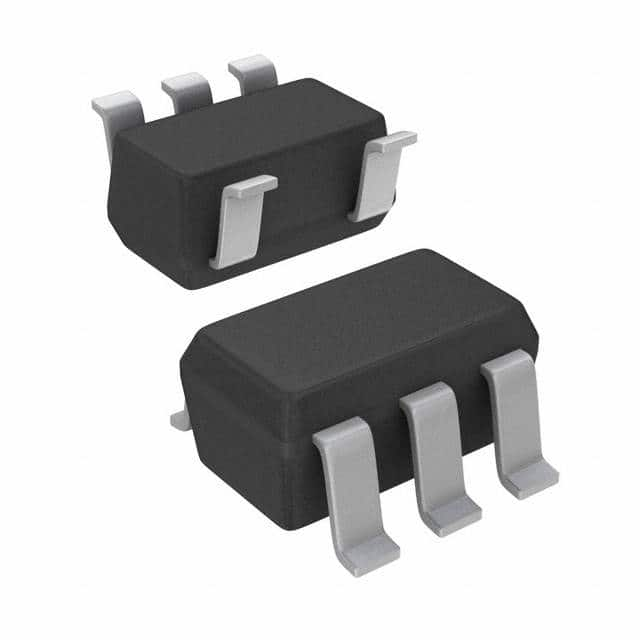Consulte las especificaciones para obtener detalles del producto.

SN74AHCT1G14DBVR
Product Overview
- Category: Integrated Circuit (IC)
- Use: Logic Gate
- Characteristics: Schmitt Trigger Inverter
- Package: SOT-23-5
- Essence: Single Schmitt-Trigger Inverter
- Packaging/Quantity: Tape and Reel, 3000 pieces per reel
Specifications
- Supply Voltage Range: 2 V to 5.5 V
- Input Voltage Range: 0 V to VCC
- Output Voltage Range: 0 V to VCC
- Operating Temperature Range: -40°C to +85°C
- Propagation Delay Time: 7 ns (typical)
- Rise/Fall Time: 3.5 ns (typical)
- Quiescent Current: 1 µA (maximum)
Detailed Pin Configuration
The SN74AHCT1G14DBVR has a total of 5 pins:
- GND (Ground): Connected to the ground reference voltage.
- A (Input): Input pin for the logic signal.
- Y (Output): Output pin for the inverted logic signal.
- VCC (Power): Connected to the positive supply voltage.
- NC (Not Connected): This pin is not connected internally and can be left unconnected.
Functional Features
- Schmitt Trigger: The SN74AHCT1G14DBVR incorporates a Schmitt trigger input, which provides hysteresis to improve noise immunity and signal integrity.
- Inverter: The IC acts as an inverter, producing the logical complement of the input signal at the output.
Advantages and Disadvantages
Advantages: - High Noise Immunity: The Schmitt trigger input ensures reliable operation even in the presence of noise. - Wide Supply Voltage Range: The IC can operate from 2 V to 5.5 V, making it compatible with a variety of systems. - Small Package Size: The SOT-23-5 package is compact and suitable for space-constrained applications.
Disadvantages: - Single Functionality: The IC only provides the functionality of a single Schmitt-trigger inverter and cannot perform other logic functions. - Limited Output Current: The output current capability of the IC is relatively low, which may restrict its use in certain applications.
Working Principles
The SN74AHCT1G14DBVR operates based on the principles of digital logic. It uses a Schmitt trigger input to convert the input signal into a clean digital output. When the input voltage crosses a certain threshold, determined by the hysteresis of the Schmitt trigger, the output switches states. This ensures that noisy or slowly changing input signals do not cause false transitions at the output.
Detailed Application Field Plans
The SN74AHCT1G14DBVR can be used in various applications, including but not limited to:
- Signal Conditioning: The Schmitt trigger functionality makes it suitable for cleaning up noisy input signals before further processing.
- Oscillators: The IC can be used to generate square wave oscillations in oscillator circuits.
- Level Shifting: It can be employed to shift logic levels between different voltage domains in mixed-voltage systems.
- Pulse Shaping: The Schmitt trigger can be utilized to shape input pulses and ensure proper triggering of downstream circuitry.
Detailed and Complete Alternative Models
- SN74LVC1G14DBVR: Similar to SN74AHCT1G14DBVR, but operates at lower supply voltages (1.65 V to 5.5 V).
- SN74AHC1G14DBVR: Another alternative with similar functionality, but operates at higher supply voltages (2 V to 5.5 V).
- SN74LV1G14DBVR: This model is similar to SN74AHCT1G14DBVR, but operates at lower supply voltages (1.65 V to 5.5 V) and has a different package (SOT-23-6).
These alternative models provide similar functionality with slight variations in voltage range and package options.
Word count: 409 words
Enumere 10 preguntas y respuestas comunes relacionadas con la aplicación de SN74AHCT1G14DBVR en soluciones técnicas
Sure! Here are 10 common questions and answers related to the application of SN74AHCT1G14DBVR:
Q1: What is SN74AHCT1G14DBVR? A1: SN74AHCT1G14DBVR is a single Schmitt-trigger inverter gate IC, commonly used in digital logic circuits.
Q2: What is the operating voltage range of SN74AHCT1G14DBVR? A2: The operating voltage range is typically between 2V and 5.5V.
Q3: What is the maximum output current of SN74AHCT1G14DBVR? A3: The maximum output current is around 8mA.
Q4: Can SN74AHCT1G14DBVR be used as a level shifter? A4: Yes, it can be used as a level shifter to convert signals between different voltage levels.
Q5: What is the propagation delay of SN74AHCT1G14DBVR? A5: The typical propagation delay is around 6ns.
Q6: Can SN74AHCT1G14DBVR be used in high-speed applications? A6: While it is not specifically designed for high-speed applications, it can still be used in moderate-speed digital circuits.
Q7: Is SN74AHCT1G14DBVR suitable for battery-powered devices? A7: Yes, it is suitable for battery-powered devices due to its low power consumption.
Q8: Can SN74AHCT1G14DBVR drive capacitive loads? A8: Yes, it can drive small capacitive loads without any additional buffering.
Q9: Can SN74AHCT1G14DBVR tolerate overvoltage conditions? A9: No, it is not designed to tolerate overvoltage conditions. It is recommended to use external protection circuitry.
Q10: Can SN74AHCT1G14DBVR be used in temperature-sensitive applications? A10: Yes, it has a wide operating temperature range of -40°C to 125°C, making it suitable for temperature-sensitive applications.
Please note that these answers are general and may vary depending on specific application requirements.

